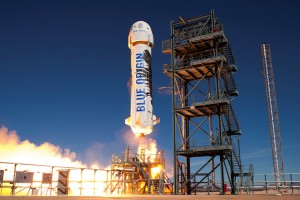New Space Aims for Mars and Beyond
October 28, 2016
Last month, two American space companies outlined ambitious plans to carry people into orbit and beyond. These companies are Blue Origin, founded by American entrepreneur Jeff Bezos, and Space Exploration Technologies Corporation (known as SpaceX), created by South African-born American businessman Elon Musk. The two companies, which were the first to successfully land rocket boosters after launch, represent the two giants of “new space,” private startups that are bringing new ideas to spaceflight.

A Blue Origin New Shepard rocket takes off from a launch pad near Van Horn, Texas, in October 2016. Credit: Blue Origin
In September, Blue Origin unveiled the New Glenn rocket, named for the first U.S. astronaut to orbit Earth, John Glenn. The rocket would be almost as large as the Saturn 5 rockets that took Apollo astronauts to the moon, and it would be larger than SpaceX’s upcoming Falcon Heavy rocket. Many of the New Glenn’s parts will be reusable. The rocket will deliver satellites and tourists to Earth orbit and possibly beyond.
Shortly after news of the New Glenn rocket came out, SpaceX’s Elon Musk detailed his incredible vision to colonize Mars. In his “Interplanetary Transport System,” an enormous colony ship would be launched into orbit by the largest booster ever created. Then, the booster would land, refuel, and launch a tanker craft into orbit to rendezvous with and refuel the colony ship. After refueling, the colony ship would pull out of Earth orbit and head to Mars. Musk estimated that each ship would host up to 100 colonists, who would pay for the honor of living the rest of their lives (most likely) on Mars. To put this in perspective, the most people carried into space at one time is 8, aboard a space shuttle, and fewer than 600 people have ever been to space at all. Musk envisions using multiple launches to establish a functional Martian colony of at least 1 million people by the end of the 2100’s. It is an ambitious plan, but most experts think that Musk has grossly underestimated the costs and timescales involved in colonizing the Red Planet.
Before these new space companies can achieve their lofty ambitions, they have to focus on present challenges. Just days before Musk’s announcement, one of SpaceX’s Falcon 9 rockets exploded on the launch pad during a test sequence. For all its successful test missions, Blue Origin’s only rocket to date, New Shepard, is a demonstration craft. (It is named for astronaut Alan Shepard, the first American in space.) Bezos’s company expects to take tourists on brief suborbital flights aboard future New Shepards as soon as 2018. Until it can reliably serve paying customers, however, Blue Origin will be thought of in some circles as a billionaire’s expensive hobby.
Another challenge will be funding. The U.S. National Aeronautics and Space Administration (NASA) has given contracts to SpaceX to resupply the International Space Station, but NASA has little use for the heavy launchers being developed by these new space companies. NASA is constructing its own large rocket, the non-reusable Space Launch System (SLS), to send probes deep into the solar system and to take astronauts to the moon and Mars aboard the Orion capsule (which is also under development). The SLS is being built largely at the same facilities used to create parts for the old space shuttle program. Because these manufacturing plants are scattered across the country and employ thousands of people, the U. S. Congress has a strong desire to continue the SLS project. Furthermore, NASA Administrator Charles Bolden stated that he’s “not a big fan” of commercial investment in large launch vehicles. Both companies need government contracts and funding to finance their rockets, so they may to look to other countries for financial support.
Many engineering, financial, and political challenges stand in each new space company’s way. But Blue Origin and SpaceX, along with other companies, have demonstrated an ability to approach spaceflight in novel ways in an attempt to drive down costs and increase reliability. If they succeed, space travel may one day become an exciting adventure that many people get to experience.


